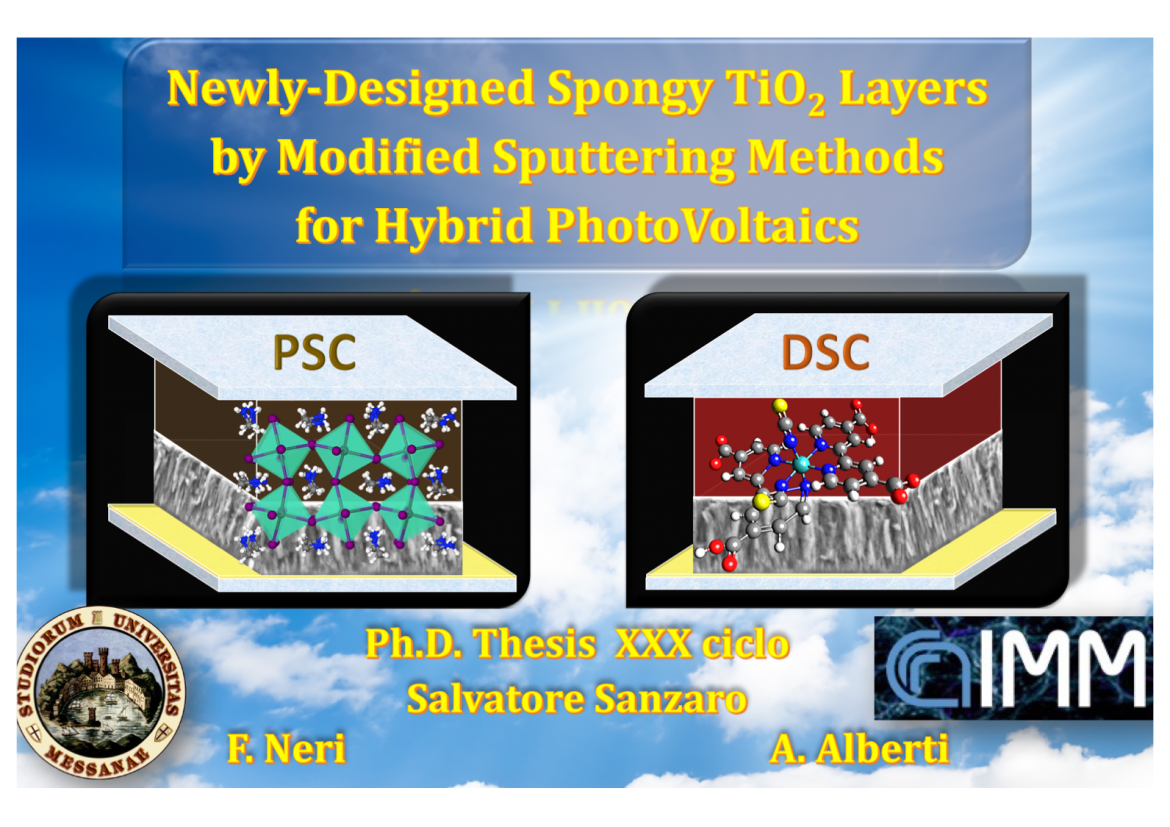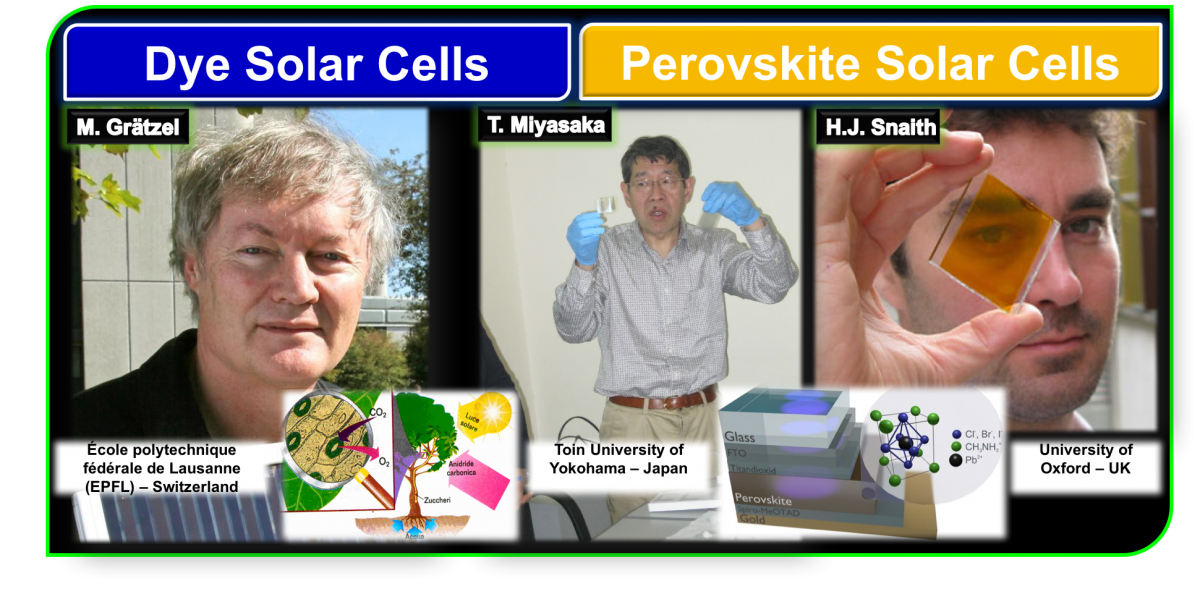
EXTENDED ABSTRACT (Full Thesis PDF Download)
The ability to build up cheap multifunctional devices envisages the possibility of a large dissemination of new technologies to improve the quality of life, worldwide. Among the requirements to hit the target of multi-functionality, multi scale-porosity is an increasingly strategic property for inorganic materials to provide simultaneous sensitivity to light, liquids, gases, complex molecules or hybrid counterparts. The control of porosity mainly in terms of size (from meso to nano) and arrangement (random vs. ordered, monodimensional vs. hierarchical) is thus a key cornerstone for the actual design and fabrication of functional devices. In order to join and simultaneously cover different fields, new material architectures with transversal empowering are required.
Porous TiO2 is currently applied for energy, health and environment purposes. Among the others, TiO2–based 1D nanostructures are especially appealing since they usually expose large active facets with good mechanical and surface-related performances, and high electrical conductivity. All those properties enrich 1D-TiO2 architectures to be efficiently used as scaffold for Dye and Perovskites Solar Cells, anodes for Li batteries, electrodes for water splitting devices, materials for biosensors detecting DNA or glucose, scaffold for gas sensing or photo-catalysis.
 Framed in this context, the main purpose of the Ph.D. thesis was designing new low-dimensional TiO2-structures through a high-throughput method which is up-scalable, contaminant-free, implementable on low cost substrates and eco-compatible in terms of waste reduction and material saving. The process is described in details and the produced materials investigated from different point of views, comprising structure, optical behavior, interface engineering, surfaces functionalization, electrical response under illumination. A plethora of techniques some of which recently developed, are used to disentangle the different properties.
Framed in this context, the main purpose of the Ph.D. thesis was designing new low-dimensional TiO2-structures through a high-throughput method which is up-scalable, contaminant-free, implementable on low cost substrates and eco-compatible in terms of waste reduction and material saving. The process is described in details and the produced materials investigated from different point of views, comprising structure, optical behavior, interface engineering, surfaces functionalization, electrical response under illumination. A plethora of techniques some of which recently developed, are used to disentangle the different properties.
The newly-conceived material, we called gig-lox TiO2, was integrated as scaffold in hybrid technologies for solar energy conversion into electricity by exploiting approaches beyond-silicon: namely, Dye Sensitized Solar Cells (DSC) and Perovskite Solar Cells (PSC). DSCs compete with silicon for Integrated Building Photovoltaics and flexible/wearable devices; whilst PSCs are attractive for two-level tandem with silicon solar cells that prospects efficiency improvement over 30%.
There is a general consensus, supported by the explosion of publications in the field during the last 8 years, that Hybrid Solar Cell technologies can breathe new life by their capillary distribution in a complementary way to silicon solar panels and plants already installed all over the world, at price competitively low (£0.5$/Wp).
To open up new opportunities for high–performance and high-throughput hybrid solar cells, the outcome of the Ph.D thesis is: 1) a new strategy enabling sputtering-based method to grow spongy-TiO2 architectures with fine control over porosity in the meso- to nano-scale; 2) providing proofs-of-concept on the material use in DSC and PSC devices; 3) demonstrating the transversal empowering of the material through its application in gas sensing devices.
We conclude that our gig-lox TiO2material opens a reliable perspective to integrate different functionalities on a shared platform for multipurpose devices.
The Ph.D. thesis is organized in four chapters.
 The first chapter is an overview on renewable energies solutions and perspectives to counteract the climate change, with special focus on the clean energy provided by the sun. In the context of the photovoltaic devices, DSC and PSC technologies, comprising their operation principles, are described as viable solutions beyond-silicon.
The first chapter is an overview on renewable energies solutions and perspectives to counteract the climate change, with special focus on the clean energy provided by the sun. In the context of the photovoltaic devices, DSC and PSC technologies, comprising their operation principles, are described as viable solutions beyond-silicon.
In the second chapter, we provide a detailed description of the newly conceived gig-lox process used for the deposition of spongy TiO2 layers. Gig-lox stems for Grazing Incidence sputtering Geometry coupled with Local OXidation. The several effects of the deposition parameters are described and exploited to the intent of properly building-up the multi-scale porosity and its solid-state frame. The properties of the gig-lox TiO2 layers are also investigated from different perspectives: morphology, lattice structure and optical behaviour in comparison to reference layers deposited by standard parallel plate sputtering methods.
Shortly following, chapter three is the proof-of concept of the mainstays of the new material. It contains the description of the TiO2 functionalization by photoactive molecules (N-719) in different solvents (CH3CH2OH and CH3CN) via a detailed characterization on the dye infiltration, chemisorption and on the collection of the photo-generated electrons. The chapter also describes the coverage of the spongy-TiO2 layers with perovskites, i.e. MAPbI3, supported by morphological, structural and optical descriptions. Finally, we report on DSC and PSC prototypal devices wherein the spongy-TiO2 is integrated as scaffold.
Chapter two and three represent the core of the Ph.D. thesis.
The fourth final chapter complements the others to explore alternative materials and applications for future devices. It contains: 1) TiO2 flowers grown by a chemical approach (AA-MOCVD) as a possible alternative to the gig-lox method; 2) the application of gig-lox TiO2 layers for gas sensing; 3) the growth of ZnO:Al (AZO) by low-temperature reactive co-sputtering as a valid alternative to commercial transparent conductive oxides (TCO) for solar cells. The chapter aims at further elucidating the transversal empowering of nanostructures and at prospecting their easy integration with Aluminum doped Zinc-Oxide (AZO) layers in a shared deposition chamber potentially on any kind of substrate. This strategy would positively impact on the costs of the photo-anode.
The Ph.D. thesis in Physics (FIS/01) was carried out as a joined work between University of Messina (Department MIFT, “Scienze Matematiche e Informatiche, Scienze Fisiche e Scienze della Terra”) and the National Research Council in Catania (CNR-IMM, Institute for Microelectronics and Microsystems) and was supported by the Italian Project “Elettronica su Plastica per Sistemi Smart disposable” (Electronics on Plastics for ‘Smart disposable’ Systems) funded by MIUR (Ministero Istruzione Università e Ricerca) to the Distretto Tecnologico Sicilia Micro e Nano Sistemi (S.C.a.R.L.) by means of the Italian Program PON02_00355_3416798. The thesis work was partially carried out at the Laboratoire des Matériaux et du Génie Physique (LMGP) in Grenoble (3-months stage) and at the European Synchrotron Radiation Facilities (ESRF), ID10 in Grenoble (1-month stage). The gas sensors were realised in collaboration with STMicroelectronics.
Tutor at CNR-IMM HQ: Alessandra Alberti
Tutor at the University of Messina: Fortunato Neri
PUBLICATIONS AND PATENT
- Sanzaro, E. Fazio, F. Neri, E. Smecca, C. Bongiorno, G. Mannino, R. A. Puglisi, A. La Magna and A. Alberti - Pervasive infiltration and multi-branch chemisorption of N719 molecules into spongy TiO2 layers deposited by gig-lox sputtering processes, Journal Materials Chemistry A, 2017, 5, 25529
- A. Alberti, L. Renna, S. Sanzaro, E. Smecca, G. Mannino, C. Bongiorno, C. Galati, L. Gervasi, A. Santangelo and A. La Magna - Innovative spongy TiO2 layers for high sensitivity gas detection at low working temperature, Sensors and Actuators B: Chemical, 2018, 259, 658-667
- A. Alberti, I. Deretzis, G. Mannino, E. Smecca, S. Sanzaro, Y. Numata, T. Miyasaka and A. La Magna - Revealing a discontinuity in the degradation behaviour of CH3NH3PbI3 during thermal operation, J. Phys. Chem., 2017, 121, 13577−13585.
- Mannino, A. Alberti, I. Deretzis, E. Smecca, S. Sanzaro, Y. Numata, T. Miyasaka and A. La Magna - First evidence of CH3NH3PbI3 optical constant improvement in N2 environment at 40-80°C, The Journal of Physical Chemistry C, 2017, 121, 7703-7710.
- Sanzaro, E. Smecca, G. Mannino, C. Bongiorno, G. Pellegrino, F. Neri, G. Malandrino, M. R. Catalano, R. Iacobellis, L. De Marco, C. Spinella, A. La Magna and A. Alberti - Multi-Scale-Porosity TiO2 scaffolds grown by innovative sputtering methods for high throughput hybrid photovoltaics, Scientific Reports, 2016, 9, 39509.
- Sanzaro, A. Alberti, E. Fazio, E. Smecca, G. Mannino, G. Malandrino, A. La Magna and F. Neri - New growth methodology to produce mesoporous TiO2 scaffolds for Dye Sensitized Solar Cells, Activity report 2015 – Dip. Di Fisica, Università degli Studi di Messina, 2016, ISSN 2838-5889.
- Sanzaro, A. La Magna, E. Smecca, G. Mannino, G. Pellegrino, E. Fazio, F. Neri and A. Alberti - Controlled Al3+ Incorporation in the ZnO Lattice at 188°C by Soft Reactive Co-Sputtering for Transparent Conductive Oxides, Energies, 2016, 9, 433-446.
- Sanzaro, A. La Magna, E. Smecca, G. Pellegrino, E. Fazio, F. Neri, A. Alberti - Dye-Sensitized Solar Cells: ZnO:Al by reactive co-sputtering in co-focal geometry, Activity report 2015 – Dip. Di Fisica, Università degli Studi di Messina, 2015, ISSN 2038-5889
- A. Alberti, C. Bongiorno, G. Pellegrino, S. Sanzaro, E. Smecca, G. G. Condorelli, A. E. Giuffrida, G. Cicala, A. Latteri, G. Ognibene, A. Cassano, A. Figoli, C. Spinella and A. La Magna – Low temperature sputtered TiO2 nano sheaths on electrospun PES fibers as high porosity photoactive material, RSC Adv., 2015, 5, 73444.
- Sanzaro, G. Pellegrino, E. Smecca, G. Malandrino, R. Catalano, A. La Magna and A. Alberti - Deposition of ZnO:Al/TiO2 bi-layers at low temperature by reactive sputtering for application as photoanodes in Dye Sensitized Solar Cells, Activity report 2014 – Dip. Di Fisica, Università degli Studi di Messina, 2014, ISSN 2038-5889.
- Patent submitted: A. Alberti, L. Renna, L. Gervasi, S. Sanzaro, E. Smecca, C. Galati, A. Santangelo, A. La Magna - Especially designed TiO2 sputtering layer for high sensitivity gas detection, 2017, ID: 82681506, 2017.

